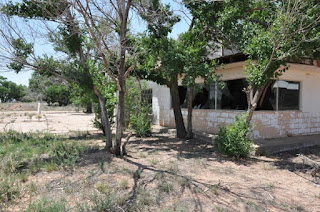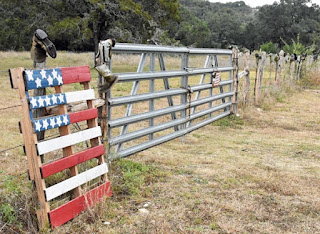 |
| Susanna Dickinson Historical photo |
Susanna and Almaron were married in 1829 when she was only 15. Almaron, an early proponent of succession from Mexico, volunteered for the Texas Army and fought in the Battle of Gonzalez, the first armed conflict which launched the Texas Revolution. He later took part in a series of skirmishes which by late 1835 forced Mexican forces out of the San Antonio area. After being assigned to the Alamo garrison, Susanna joined Almaron and they lived in a house outside of the Alamo's grounds.
On February 23, 1836, Mexican president Santa Anna led approximately 4,000 troops into San Antonio. For safety, Almaron quickly brought Susanna and little Angelina inside the walls of the Alamo. For the next 13 days, the Mexican army lay siege to the Alamo. During this time, Susanna cooked for the 189 defenders and cared for the wounded and sick.
At 5:30am the morning of March 6, Santa Anna gave the order to his troops to advance.
The entrance to the chapel had been barricaded with sandbags, which the Texans were able to fire over, but a shot from the Mexican 18-pounder cannon destroyed the barricade and Mexican soldiers entered after an initial musket
volley. Dickinson's crew fired their cannons into the Mexican soldiers, killing and wounding a large number of them, but they had no time to reload. Dickinson, Gregorio Esparza, James Bonham (the 29-year-old 2nd cousin of Travis who came to the Alamo with Jim Bowie), and the remaining Texans grabbed rifles and fired before being bayoneted to death. Texan Robert Evans, the master of ordinance, had been tasked with keeping the gunpowder from falling into Mexican hands. Severely wounded, he crawled towards the powder magazine but was killed by a musket ball with his torch only inches from the powder. If he had succeeded, the blast would have destroyed the chapel, killing Susanna and the other women and children hiding in it. As soldiers approached the sacristy, the 8-year-old son of defender Anthony Wolf stood to pull a blanket over his shoulders. Four Mexican soldiers killed him with their bayonets.
 |
| Angelina Dickinson Historical Photo |
After arriving in Gonzales on March 13, the three found Sam Houston and told him of the fall of the Alamo. They also told him of the number of Mexican forces and the armament they carried. She also told details of the 13-day siege, the final battle and the aftermath. Over the years, she stated:
- There were very few causalities among the Texans during the first 12 days of almost unceasing bombardment from Mexican cannons. She confirmed the legendary "line in the sand" incident, where Colonel Travis gave defenders the choice of staying or leaving.
- On the morning of the assault, Almaron ran into where she had hidden, made his final statements to her and then returned to his duty. She never saw him again, nor did she ever see his body.
- The two young sons of artilleryman Anthony Wolf,> ages eleven and twelve, ran to their father as the Mexican soldiers entered the chapel. She watched as they were bayoneted to death, along with their father.
- When she was discovered, a Mexican officer intervened. She believed he was a British mercenary named Almonte. He actually was Juan Almonte, who spoke perfect English, as he had been educated in New Orleans.
- Outside the chapel, there was a single survivor, found hiding, who unsuccessfully begged for mercy and was killed. Joe also reported this.
- She saw the body of Davy Crockett lying among a number of Mexican bodies between the chapel and the barracks building.
- She saw the body of Jim Bowie with two dead Mexican soldiers lying beside him.
- She was taken to the house where she'd previously lived and from there could see the pyres of the dead Texans being burned.
- Santa Anna had her identify the bodies of all the commanders and main defenders.
Being illiterate, Susanna left no written accounts, but gave the same verbal recollections on several occasions. After Texas defeated Santa Anna and his forces at San Jacinto and won its independence, Susanna moved to Houston and married again the next year. She very quickly divorced him on the grounds of cruelty. She married again in 1838, but her husband died several years later of alcoholism. She married a man by the name of Bellows in 1847, but they divorced in 1857 after he found she was having an affair. Outraged at the scandal, members of the First Baptist Church objected to her attendance there. She voluntarily left the congregation.
 Susanna married for the 5th and final time in 1858 to J. W. Hannig, a cabinet maker who was 20 years younger than her. They moved to Austin and she remained married to him until her death there in 1883. She was buried in Oakwood Cemetery with her stone inscribed "Sacred to the Memory of Susan A. Wife of J. W. Hannig Died Oct. 7, 1883 Aged 68 Years." Some modern day researchers and analyst claim she probably suffered from Post Traumatic Stress Syndrome (PTSD) due to her traumatic experience at the Alamo and this affected her path in life. Hannig followed her in death in 1890. The state of Texas added a marble slab above her grave on March 2, 1949. Because of her tarnished reputation, the marker simply reads “Mother of the Babe of the Alamo.” In 1993, a cenotaph honoring Susanna was placed in the Texas State Cemetery in Austin.
Susanna married for the 5th and final time in 1858 to J. W. Hannig, a cabinet maker who was 20 years younger than her. They moved to Austin and she remained married to him until her death there in 1883. She was buried in Oakwood Cemetery with her stone inscribed "Sacred to the Memory of Susan A. Wife of J. W. Hannig Died Oct. 7, 1883 Aged 68 Years." Some modern day researchers and analyst claim she probably suffered from Post Traumatic Stress Syndrome (PTSD) due to her traumatic experience at the Alamo and this affected her path in life. Hannig followed her in death in 1890. The state of Texas added a marble slab above her grave on March 2, 1949. Because of her tarnished reputation, the marker simply reads “Mother of the Babe of the Alamo.” In 1993, a cenotaph honoring Susanna was placed in the Texas State Cemetery in Austin.
 Susanna married for the 5th and final time in 1858 to J. W. Hannig, a cabinet maker who was 20 years younger than her. They moved to Austin and she remained married to him until her death there in 1883. She was buried in Oakwood Cemetery with her stone inscribed "Sacred to the Memory of Susan A. Wife of J. W. Hannig Died Oct. 7, 1883 Aged 68 Years." Some modern day researchers and analyst claim she probably suffered from Post Traumatic Stress Syndrome (PTSD) due to her traumatic experience at the Alamo and this affected her path in life. Hannig followed her in death in 1890. The state of Texas added a marble slab above her grave on March 2, 1949. Because of her tarnished reputation, the marker simply reads “Mother of the Babe of the Alamo.” In 1993, a cenotaph honoring Susanna was placed in the Texas State Cemetery in Austin.
Susanna married for the 5th and final time in 1858 to J. W. Hannig, a cabinet maker who was 20 years younger than her. They moved to Austin and she remained married to him until her death there in 1883. She was buried in Oakwood Cemetery with her stone inscribed "Sacred to the Memory of Susan A. Wife of J. W. Hannig Died Oct. 7, 1883 Aged 68 Years." Some modern day researchers and analyst claim she probably suffered from Post Traumatic Stress Syndrome (PTSD) due to her traumatic experience at the Alamo and this affected her path in life. Hannig followed her in death in 1890. The state of Texas added a marble slab above her grave on March 2, 1949. Because of her tarnished reputation, the marker simply reads “Mother of the Babe of the Alamo.” In 1993, a cenotaph honoring Susanna was placed in the Texas State Cemetery in Austin.
One of the surviving Hispanic children, Alejo Pérez, Jr., was the son of Juana Alsbury and her husband, Alamo defender Alejo Pérez, Sr. He was brought into the Alamo by his mother and was seventeen days short of his first birthday at the time of the last assault. He grew up and lived his whole life in San Antonio, where he was later a policeman. He died on October 19, 1918, the last survivor of the Alamo.






































